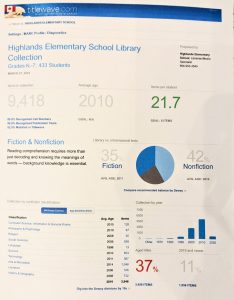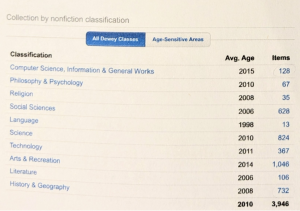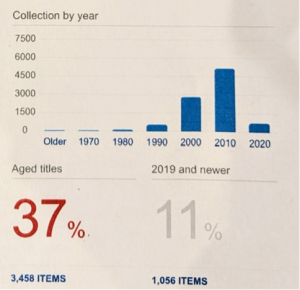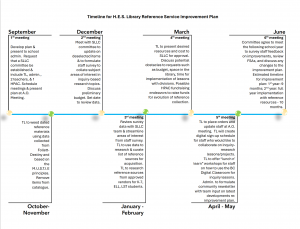This evaluation plan documents the reference collection in the Highlands Elementary School Library. Below details an overview of the school population, analysis of references, rationale for suggested improvements, action plan, timeline, and communication to stakeholders.
Overview, Analysis of Reference Collection, and Rationale
Highlands Elementary School serves students K-7 within the Edgemont community of North Vancouver. The school community is comprised of over 105 ELL students who are a mix of internationals, refugees, and landed immigrants. The SLLC operates with a full-time Teacher-Librarian who delivers a scheduled, non-instructional block for each division 1/week for 40 minutes which incorporates book exchange and information science lessons. There are 6-40 minute open blocks/week for divisions to use the SLLC for research and collaborative projects. The annual operating budget is $2000 – just under $5.00/student. This is below the recommended acceptable level of funding of $26-$35/student (Canadian Association for School Libraries, 2003).
To determine how reference services can be improved, an analysis of the reference collection was needed. A mapping of the non-fiction and reference collection was conducted based on the methods outlined by David Loertscher (Loertscher). Using Titlewave to generate a summary of the collection indicated the following statistics.
The SLLC houses 9, 418 physical items in its collection (Image 1) https://www.titlewave.com/titlewise/dispsingle?caid=4871506

Image 1
with 3,946 items categorized as non-fiction. With a student population of 434 students, this translates into 21.7 items/student.
Specifically, the reference items have been itemized by type (Table 1).

Table 1
Ages of the reference items range from 26 to 9 years since publication (Image 2).

Image 2
with most published between 2010 – 2019 (Image 3).

Image 3
Age of the collection is Below Standard. This is due to lack of weeding and limited budget.
The SLLC no longer houses encyclopedias, bibliographies, or almanacs. Reliance on the digital platform of Focused Education BC provides students with access to these sources.
When comparing the number of reference items (print = 327; digital = 18) to the student population, a 0.80 ratio, per student, was determined. Comparing this data to the baselines given in Achieving Information Literacy: Standards for School Libraries in Canada (2003), the data indicates the reference collection in HES per student ratio is Below Standard.
The collection was then measured against Riedling’s. baselines for replacing reference materials. Table 2 lists guidelines for replacement (Riedling, Shake, & and Houston, 2013). When measured against the average age of print reference resources, the collection is rated at Below Standard.

Table 2
The data above reflects that the reference collection is evaluated at Below Standard in the areas of budget, ratio of resources to students, and for types of resources – both in print and electronic forms for non-fiction, and age of resources (Canadian Association for School Libraries, 2003).
Examining student performance, Highland’s students, on average, score at or above provincial averages based on the 2021/2022 Foundation Skills Assessment results for SD #44 (Province of British Columbia Ministry of Education, 2022). However, in the Informational Text section of the literacy test, Grade 4’s received lower scores indicating that many students were unable to use the required skills to locate and retrieve data from Informational Text questions (Province of British Columbia Ministry of Education, 2022). This indicates that more time is required for the TL to work with classes on how to read and comprehend non-fictive texts.
Given the ratings measured from the above guidelines from two noted and authoritative sources and student performance on provincial FSA’s, it is necessary that a plan be developed and implemented to improve reference services. Doing so will enable the SLLC collection to support teachers and students in their endeavors to engage in the current 21st century learning goals of the BC Curriculum.
Plan
Weeding outdated reference material, increasing the budget for acquiring new resources, and specific teaching of research skills are recommended to improve the reference services of Highlands Elementary School Library. Below outlines a step-by-step process for plan implementation with suggested timeframes.
timeline for improvement plan assgn3
By implementing the recommendations, the reference services and collection will evolve to meet average to exemplary standards and will be able to best serve the learning and curriculum needs of the school community.
References
Canadian Association for School Libraries. (2003). Achieving Information Literacy – Standards for School Library Programs in Canada. (M. Asselin, J. L. Branch, & D. and Oberg, Eds.) Ottawa, Ontario, Canada. Retrieved 2024, from http://accessola2.com/SLIC-Site/slic/ail110217.pdf
Loertscher, D. V. (n.d.). Collection Mapping in the LMC – Building Access in a World of Technology. Excellence in School Library Media Programs, 3. San Jose, California: Hi Willow Research and Publishing. Retrieved from https://www.davidloertscherlibrary.org/wp-content/uploads/2020/05/1996-Collection-Mapping-in-the-LMC-Building-Access-in-a-World-of-Technology.pdf
Province of British Columbia Ministry of Education. (2022). North Vancouver (44) Foundation Skills Assessment. Retrieved January 22, 2023, from https://studentsuccess.gov.bc.ca/school-district/044/report/fsa
Riedling, A. M., Shake, L., & and Houston, C. (2013). Reference Skills for the School Librarian: Tools and Tips (3rd ed.). Santa Barbara, California: Linworth – ABC-CLIO, LLC.


Hi Linette,
This is a great example of a technical essay, with clear data, and a rational and actionable plan that administrators would appreciate and understand.
I must say that I am jealous of the reports and wealth of information you can get about your catalogue so easily using your Follett Destiny and Titlewave software. On PEI, the only OPAC software we have access to is an extremely old version of Koha, and the report generation function is not user friendly or customizable.